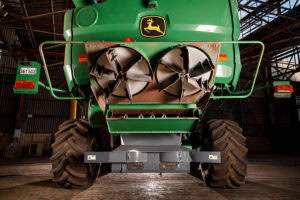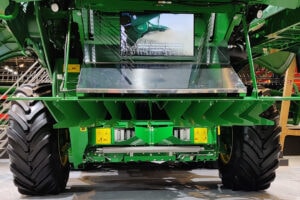Weed seed bites the dust

A new entrant pushes into the competitive market of weed seed mill attachments for combines, while established units are refined.
There’s an urgent need for tackling the problem of weed resistance to herbicides, and newish technologies are being refined – and launched – right now to address the issue.
264 resistant species
Herbicide resistance is a very serious issue affecting crop growers all over the world. According to The International Survey of Herbicide-Resistant Weeds, there are now 264 resistant species, with resistant populations in 95 crops and 71 countries. Weeds have evolved resistance to 21 of the 31 known herbicide ‘modes of action’ and to 164 different herbicides.
Farmers, being the resourceful group they are, continue to try various solutions such as changing up herbicide application mixes and cropping practices when possible. But what happens at harvest also matters.
Weed seed
At harvest, combining causes the problem of herbicide resistance to get a whole lot worse. During the normal process, the chaff and grain are separated and the chaff is then dispersed back onto the field. There is weed seed in that chaff, the seed of weeds that have survived herbicide application. Dispersing the seeds of these survivors sets them up for wider success during the next growing season.
Some farmers make narrow ‘windrows’ with the chaff and burn it. Some collect the chaff in a cart and compost or bale it. And some are using newish technology – weed seed mills placed onto combines – that pulverizes the weed seed encountered during the harvesting process into dust.
Established models approach or achieve 99% effectiveness in weed seed destruction. However, a 2020 study at University of Illinois found that “quite possibly the need for total destruction of seed is not necessary for good control,” and if even minimal damage to the weed seed coat occurs, microbes will attack and kill the seed.
Four units on the market
‘Mechanical harvest weed seed control,’ as it’s technically called, works on weeds that are still holding onto their seeds at harvest and are tall enough to be captured by the combine. There are now at least four units on the market. Three continue to be refined and a new one is launching next month, Nov. 2021 (see side boxes).
Customer experiences

Damien Schneider, owner of Gunnadoo Grain near Culcairn, Australia, has run his ‘Seed Terminator’ (ST) through two harvests and will use it again this harvest, which starts in November. “Rye grass is the big issue here,” Schneider reports. “It’s resistant to post-emergent herbicides and can’t be controlled in cereal crops. Wild radish is also a problem.”
Whilst Schneider expected it would be two or three years before his ST made any impact, he saw a significant difference in weed control right away. “In the first year after use, I had only 10 weeds/m2 and the next year, 2 to 5/m2,” he says. “It’s been an amazing difference.”
With increased yield, I think the unit is paying for itself pretty fast
In terms of ROI, Schneider says “it’s obviously an expensive machine, but I considered it reasonable on a per-acre cost. It does take a lot of engine power so there’s slightly higher fuel consumption. I haven’t yet reduced the amount of pre-emergent herbicide I use due to wanting to use all the different methods available to me, but I should be able to use less going forward. But with less rye grass weed pressure, the crops can grow that much better and with increased yield, I think the unit is paying for itself pretty fast. With the weeds under much better control, it also allows me to completely change what I will grow in a particular field.” These crops include wheat, barley, canola, lupins and fava beans.

Josh Heidt, who farms in Saskatchewan, Canada, purchased one Redekop MAV Seed Control Unit (SCU) during 2020. “We had six combines running that season and I felt like I wasn’t able to keep up with the pace of the rest of the combines and do all the spots I wanted with the SCU,” he says. “This season we ran seven combines with two SCUs and it was more manageable.”
We have a few problem fields that we will do completely with the SCU
Heidt and his team are mainly targeting kochia, cleavers, wild mustard and wild oats; all of these weeds are known to have herbicide resistance in the area around the farm. “For the most part we only have small patches of these weeds, so the regular combines cut around them and save them for the SCU, but we have a few problem fields that we will do completely with the SCU,” Heidt reports. “And we also like to combine the opening rounds of every field with the SCU as there tends to be a heavier concentration of weeds along the field boundary.”

Heidt explains that seed from wild mustard, wild oats, and cleavers can sit dormant in the soil for many years, while kochia seed can only survive a couple of years. For that reason, it’s easier to see the effect of the SCU on the kochia. However, particularly with wild oats but also some other weeds, pod shatter/seed drop before harvest time can happen, which, he says, “can make long-term control very challenging.”
As they have fore many years, crop protection product-makers are working hard to create new herbicide modes of action. But in the meantime, weed seed mills remain an important tool in the crop farmer’s chest.
Weed seed mills – an overview:
- generally offer changeover to windrow mode as standard or optional
- easy to install and set up
- managed by monitor in tractor (showing RPMs etc.)
- all models have different hammer mill orientations and designs; design details are proprietary
- refinements continue related to durability, lower maintenance, lower power usage, etc.
Join 17,000+ subscribers
Subscribe to our newsletter to stay updated about all the need-to-know content in the agricultural sector, two times a week.



